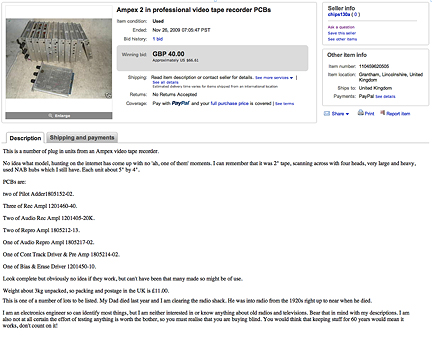[Click on image to enlarge] Does any one at NASA Langley Research Center (or elsewhere in/around NASA) know where this large reproduction of the Lunar Orbiter 1 “Earthrise” image (or others like it) are currently located? Please drop an email to lunarorbiter-at-spaceref.com – thanks!
Image date: 12.14.1966 Caption: “Langley Center Director Floyd Thompson shows Ann Kilgore the “picture of the century.” This was the first picture of the earth taken from space. From Spaceflight Revolution: “On 23 August 1966 just as Lunar Orbiter I was about to pass behind the moon, mission controllers executed the necessary maneuvers to point the camera away from the lunar surface and toward the earth. The result was the world’s first view of the earth from space. It was called “the picture of the century’ and “the greatest shot taken since the invention of photography.” Not even the color photos of the earth taken during the Apollo missions superseded the impact of this first image of our planet as a little island of life floating in the black and infinite sea of space.” Published in James R. Hansen, Spaceflight Revolution: NASA Langley Research Center From Sputnik to Apollo, (Washington: NASA, 1995), pp. 345-346.”
Image reference at NASAimages.org

“Attached is a photo that I have of the Lunar Orbiter photo. I got if from my Dad who worked for North American Rockwell at the time this photo was taken. Is about 15″ x 40”. And states “Historic First Photo of Earth from Deep Space”. Robert L. Wells, Salem, AL
“Griffith Observatory has a copy of the print, identical in size to the one shown in your story. It was somewhat worse-the-wear for being on public display for decades, and although it had some cosmetic restoration, it was crated and put in storage (where it remains) when the Observatory was closed for renovation in 2002.” – Anthony Cook, Astronomical Observer, Griffith Observatory
“I don’t know if it was a reprint or not, but we had one at Michoud Assembly Facility. It was there from the Saturn program. It hung on the Main isle. West side of the plant, on the north wall. It was across from the Mechanical Assembly area. Think around column K-4, but can’t stake my life on the exact column number. Hope this helps, maybe give them a call.” – Danny
Click on image to enlarge. “Hello… I wished that I had the large version in the story but I have had the smaller version since the 60’s rolled up for a number of years and finally had the print framed about 25 years ago. Right now, it is in storage. As you can see, I brought it out to show some friends for a time and took a photo of it in front of my front door…. It is in fairly good shape, still. It was given to me from a friend that worked at JPL. It is one of my prized pictures and it is heart breaking that I don’t have a wall to display it…. “ Ernie Williams Cerritos, CA



 Bruce K. Byers, NASA Headquarters, Washington, D.C. 1977, NASA TM X-3487
Bruce K. Byers, NASA Headquarters, Washington, D.C. 1977, NASA TM X-3487 
 Don Edward Wilhelms received the Shoemaker Distinguished Lunar Scientist Award last night during a ceremony of the Lunar Science Forum at NASA’s Ames Research Center, Moffett Field, Calif. The award is given annually to a scientist who has significantly contributed to the field of lunar science.
Don Edward Wilhelms received the Shoemaker Distinguished Lunar Scientist Award last night during a ceremony of the Lunar Science Forum at NASA’s Ames Research Center, Moffett Field, Calif. The award is given annually to a scientist who has significantly contributed to the field of lunar science. Join the Lunar and Planetary Institute on April 21, 2010, for a live video webcast with Delia Santiago. She will discuss an exciting new citizen scientist program called MoonZoo. The rest of the conversation is up to you!
Join the Lunar and Planetary Institute on April 21, 2010, for a live video webcast with Delia Santiago. She will discuss an exciting new citizen scientist program called MoonZoo. The rest of the conversation is up to you!


 Dennis Wingo: Last night on the Ampex mailing list the following message was posted:
Dennis Wingo: Last night on the Ampex mailing list the following message was posted:
